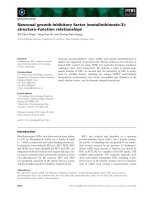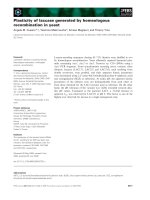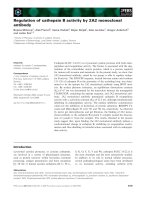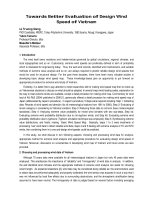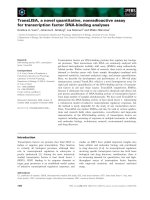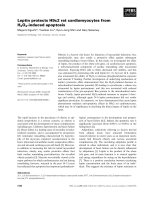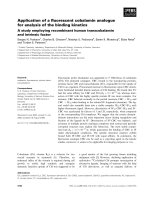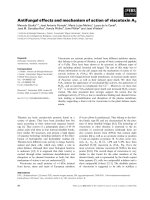Tài liệu Báo cáo khoa học: "Towards History-based Grammars: Using Richer Models for Probabilistic Parsing*" docx
Bạn đang xem bản rút gọn của tài liệu. Xem và tải ngay bản đầy đủ của tài liệu tại đây (532.78 KB, 7 trang )
Towards History-based Grammars:
Using Richer Models for Probabilistic Parsing*
Ezra Black Fred Jelinek John Lafferty David M. Magerman
Robert Mercer Salim Roukos
IBM T. J. Watson Research Center
Abstract
We describe a generative probabilistic model of
natural language, which we call HBG, that takes
advantage of detailed linguistic information to re-
solve ambiguity. HBG incorporates lexical, syn-
tactic, semantic, and structural information from
the parse tree into the disambiguation process in a
novel way. We use a corpus of bracketed sentences,
called a Treebank, in combination with decision
tree building to tease out the relevant aspects of a
parse tree that will determine the correct parse of
a sentence. This stands in contrast to the usual ap-
proach of further grammar tailoring via the usual
linguistic introspection in the hope of generating
the correct parse. In head-to-head tests against
one of the best existing robust probabilistic pars-
ing models, which we call P-CFG, the HBG model
significantly outperforms P-CFG, increasing the
parsing accuracy rate from 60% to 75%, a 37%
reduction in error.
Introduction
Almost any natural language sentence is ambigu-
ous in structure, reference, or nuance of mean-
ing. Humans overcome these apparent ambigu-
ities by examining the contez~ of the sentence.
But what exactly is context? Frequently, the cor-
rect interpretation is apparent from the words or
constituents immediately surrounding the phrase
in question. This observation begs the following
question: How much information about the con-
text of a sentence or phrase is necessary and suffi-
cient to determine its meaning? This question is at
the crux of the debate among computational lin-
guists about the application and implementation
of statistical methods in natural language under-
standing.
Previous work on disambiguation and proba-
bilistic parsing has offered partial answers to this
question. Hidden Markov models of words and
*Thanks to Philip Resnik and Stanley Chen for
their valued input.
their tags, introduced in (5) and (5) and pop-
ularized in the natural language community by
Church (5), demonstrate the power of short-term
n-gram statistics to deal with lexical ambiguity.
Hindle and Rooth (5) use a statistical measure
of lexical associations to resolve structural am-
biguities. Brent (5) acquires likely verb subcat-
egorization patterns using the frequencies of verb-
object-preposition triples. Magerman and Mar-
cus (5) propose a model of context that combines
the n-gram model with information from dominat-
ing constituents. All of these aspects of context
are necessary for disambiguation, yet none is suf-
ficient.
We propose a probabilistic model of context
for disambiguation in parsing, HBG, which incor-
porates the intuitions of these previous works into
one unified framework. Let p(T, w~) be the joint
probability of generating the word string w~ and
the parse tree T. Given w~, our parser chooses as
its parse tree that tree T* for which
T" =arg maxp(T, w~) (1)
T6~(~)
where ~(w~) is the set of all parses produced by
the grammar for the sentence w~. Many aspects of
the input sentence that might be relevant to the
decision-making process participate in the prob-
abilistic model, providing a very rich if not the
richest model of context ever attempted in a prob-
abilistic parsing model.
In this paper, we will motivate and define the
HBG model, describe the task domain, give an
overview of the grammar, describe the proposed
HBG model, and present the results of experi-
ments comparing HBG with an existing state-of-
the-art model.
Motivation for History-based
Grammars
One goal of a parser is to produce a grammatical
interpretation of a sentence which represents the
31
syntactic and semantic intent of the sentence. To
achieve this goal, the parser must have a mecha-
nism for estimating the coherence of an interpreta-
tion, both in isolation and in context. Probabilis-
tic language models provide such a mechanism.
A probabilistic language model attempts
to estimate the probability of a sequence
of sentences and their respective interpreta-
tions (parse trees) occurring in the language,
:P(SI TI S2 T2 S,, T,~).
The difficulty in applying probabilistic mod-
els to natural language is deciding what aspects
of the sentence and the discourse are relevant to
the model. Most previous probabilistic models of
parsing assume the probabilities of sentences in a
discourse are independent of other sentences. In
fact, previous works have made much stronger in-
dependence assumptions. The P-CFG model con-
siders the probability of each constituent rule in-
dependent of all other constituents in the sen-
tence. The :Pearl (5) model includes a slightly
richer model of context, allowing the probability
of a constituent rule to depend upon the immedi-
ate parent of the rule and a part-of-speech trigram
from the input sentence. But none of these mod-
els come close to incorporating enough context to
disambiguate many cases of ambiguity.
A significant reason researchers have limited
the contextual information used by their mod-
els is because of the difficulty in estimating very
rich probabilistic models of context. In this work,
we present a model, the history-based grammar
model, which incorporates a very rich model of
context, and we describe a technique for estimat-
ing the parameters for this model using decision
trees. The history-based grammar model provides
a mechanism for taking advantage of contextual
information from anywhere in the discourse his-
tory. Using decision tree technology, any question
which can be asked of the history (i.e. Is the sub-
ject of the previous sentence animate? Was the
previous sentence a question? etc.) can be incor-
porated into the language model.
The History-based Grammar Model
The history-based grammar model defines context
of a parse tree in terms of the leftmost derivation
of the tree.
Following (5), we show in Figure 1 a context-
free grammar (CFG) for
a'~b "~
and the parse tree
for the sentence
aabb.
The leftmost derivation of
the tree T in Figure 1 is:
"P1 'r2 'P3
S ~ ASB * aSB ~ aABB ~-~ aaBB ~-h aabB Y-~
(2)
where the rule used to expand the i-th node of
the tree is denoted by ri. Note that we have in-
aabb
S , ASBIAB
A , a
B ~ b
(,
6
/
".,
4-5.:
a a b b
Figure h Grammar and parse tree for
aabb.
dexed the non-terminal (NT) nodes of the tree
with this leftmost order. We denote by ~- the sen-
tential form obtained just before we expand node
i. Hence, t~ corresponds to the sentential form
aSB
or equivalently to the string rlr2. In a left-
most derivation we produce the words in left-to-
right order.
Using the one-to-one correspondence between
leftmost derivations and parse trees, we can
rewrite the joint probability in (1) as:
~r~
p(T,
w~) = H p(r, ]t[)
i=1
In a probabilistic context-free grammar (P-CFG),
the probability of an expansion at node i depends
only on the identity of the non-terminal Ni, i.e.,
p(r lq) = Thus
v(T, = II
i 1
So in P-CFG the derivation order does not affect
the probabilistic model 1.
A less crude approximation than the usual P-
CFG is to use a decision tree to determine which
aspects of the leftmost derivation have a bear-
ing on the probability of how node i will be ex-
panded. In other words, the probability distribu-
tion p(ri ]t~) will be modeled by
p(ri[E[t~])
where
E[t] is the equivalence class of the history ~ as
determined by the decision tree. This allows our
1Note the abuse of notation since we denote by
p(ri) the conditional probability of rewriting the non-
terminal AT/.
32
probabilistic model to use any information any-
where in the partial derivation tree to determine
the probability of different expansions of the i-th
non-terminal. The use of decision trees and a large
bracketed corpus may shift some of the burden of
identifying the intended parse from the grammar-
ian to the statistical estimation methods. We refer
to probabilistic methods based on the derivation
as History-based Grammars (HBG).
In this paper, we explored a restricted imple-
mentation of this model in which only the path
from the current node to the root of the deriva-
tion along with the index of a branch (index of
the child of a parent ) are examined in the decision
tree model to build equivalence classes of histories.
Other parts of the subtree are not examined in the
implementation of HBG.
[N It_PPH1 N]
IV indicates_VVZ
[Fn [Fn~whether_CSW
[N a_AT1 call_NN1 N]
[V completed_VVD successfully_RR V]Fn&]
or_CC
[Fn+ iLCSW
[N some_DD error_NN1 N]@
[V was_VBDZ detected_VVN V]
@[Fr that_CST
[V caused_VVD
IN the_AT call_NN1 N]
[Ti to_TO fail_VVI Wi]V]Fr]Fn+]
Fn]V]._.
Figure 2: Sample bracketed sentence from Lan-
caster Treebank.
Task Domain
We have chosen computer manuals as a task do-
main. We picked the most frequent 3000 words
in a corpus of 600,000 words from 10 manuals as
our vocabulary. We then extracted a few mil-
lion words of sentences that are completely cov-
ered by this vocabulary from 40,000,000 words of
computer manuals. A randomly chosen sentence
from a sample of 5000 sentences from this corpus
is:
396. It indicates whether a call completed suc-
cessfully or if some error was detected that
caused the call to fail.
To define what we mean by a correct parse,
we use a corpus of manually bracketed sentences
at the University of Lancaster called the Tree-
bank. The Treebank uses 17 non-terminal labels
and 240 tags. The bracketing of the above sen-
tence is shown in Figure 2.
A parse produced by the grammar is judged
to be correct if it agrees with the Treebank parse
structurally and the NT labels agree. The gram-
mar has a significantly richer NT label set (more
than 10000) than the Treebank but we have de-
fined an equivalence mapping between the gram-
mar NT labels and the Treebank NT labels. In
this paper, we do not include the tags in the mea-
sure of a correct parse.
We have used about 25,000 sentences to help
the grammarian develop the grammar with the
goal that the correct (as defined above) parse is
among the proposed (by the grammar) parses for
sentence. Our most common test set consists of
1600 sentences that are never seen by the gram-
marian.
The
Grammar
The grammar used in this experiment is a broad-
coverage, feature-based unification grammar. The
grammar is context-free but uses unification to ex-
press rule templates for the the context-free pro-
ductions. For example, the rule template:
(3)
: n unspec : n
corresponds to three CFG productions where the
second feature : n is either s, p, or : n. This rule
template may elicit up to 7 non-terminals. The
grammar has 21 features whose range of values
maybe from 2 to about 100 with a median of 8.
There are 672 rule templates of which 400 are ac-
tually exercised when we parse a corpus of 15,000
sentences. The number of productions that are
realized in this training corpus is several hundred
thousand.
P-CFG
While a NT in the above grammar is a feature
vector, we group several NTs into one class we call
a mnemonic represented by the one NT that is
the least specified in that class. For example, the
mnemonic VBOPASTSG* corresponds to all NTs
that unify with:
pos v 1
v ~.ype = be
(4)
tense - aspect : past
We use these mnemonics to label a parse tree
and we also use them to estimate a P-CFG, where
the probability of rewriting a NT is given by the
probability of rewriting the mnemonic. So from
a training set we induce a CFG from the actual
mnemonic productions that are elicited in pars-
ing the training corpus. Using the Inside-Outside
33
algorithm, we can estimate P-CFG from a large
corpus of text. But since we also have a large
corpus of bracketed sentences, we can adapt the
Inside-Outside algorithm to reestimate the prob-
ability parameters subject to the constraint that
only parses consistent with the Treebank (where
consistency is as defined earlier) contribute to the
reestimation. From a training run of 15,000 sen-
tences we observed 87,704 mnemonic productions,
with 23,341 NT mnemonics of which 10,302 were
lexical. Running on a test set of 760 sentences 32%
of the rule templates were used, 7% of the lexi-
cal mnemonics, 10% of the constituent mnemon-
ics, and 5% of the mnemonic productions actually
contributed to parses of test sentences.
Grammar and Model Performance
Metrics
To evaluate the performance of a grammar and an
accompanying model, we use two types of mea-
surements:
• the any-consistent rate, defined as the percent-
age of sentences for which the correct parse is
proposed among the many parses that the gram-
mar provides for a sentence. We also measure
the parse base, which is defined as the geomet-
ric mean of the number of proposed parses on a
per word basis, to quantify the ambiguity of the
grammar.
• the Viterbi rate defined as the percentage of sen-
tences for which the most likely parse is consis-
tent.
The any-contsistentt rate is a measure of the gram-
mar's coverage of linguistic phenomena. The
Viterbi rate evaluates the grammar's coverage
with the statistical model imposed on the gram-
mar. The goal of probabilistic modelling is to pro-
duce a Viterbi rate close to the anty-contsistentt rate.
The any-consistent rate is 90% when we re-
quire the structure and the labels to agree and
96% when unlabeled bracketing is required. These
results are obtained on 760 sentences from 7 to 17
words long from test material that has never been
seen by the grammarian. The parse base is 1.35
parses/word. This translates to about 23 parses
for a 12-word sentence. The unlabeled Viterbi rate
stands at 64% and the labeled Viterbi rate is 60%.
While we believe that the above Viterbi rate
is close if not the state-of-the-art performance,
there is room for improvement by using a more re-
fined statistical model to achieve the labeled any-
contsistent rate of 90% with this grammar. There
is a significant gap between the labeled Viterbiand
any-consistent rates: 30 percentage points.
Instead of the usual approach where a gram-
marian tries to fine tune the grammar in the hope
of improving the Viterbi rate we use the combina-
tion of a large Treebank and the resulting deriva-
tion histories with a decision tree building algo-
rithm to extract statistical parameters that would
improve the Viterbi rate. The grammarian's task
remains that of improving the any-consistent rate.
The history-based grammar model is distin-
guished from the context-free grammar model in
that each constituent structure depends not only
on the input string, but also the entire history up
to that point in the sentence. In HBGs, history
is interpreted as any element of the output struc-
ture, or the parse tree, which has already been de-
termined, including previous words, non-terminal
categories, constituent structure, and any other
linguistic information which is generated as part
of the parse structure.
The HBG Model
Unlike P-CFG which assigns a probability to a
mnemonic production, the HBG model assigns a
probability to a rule template. Because of this the
HBG formulation allows one to handle any gram-
mar formalism that has a derivation process.
For the HBG model, we have defined about
50 syntactic categories, referred to as Syn, and
about 50 semantic categories, referred to as Sere.
Each NT (and therefore mnemonic) of the gram-
mar has been assigned a syntactic (Syn) and a
semantic (Sem) category. We also associate with
a non-terminal a primary lexical head, denoted by
H1, and a secondary lexical head, denoted by H~. 2
When a rule is applied to a non-terminal, it indi-
cates which child will generate the lexical primary
head and which child will generate the secondary
lexical head.
The proposed generative model associates for
each constituent in the parse tree the probability:
p( Syn, Sern, R, H1, H2
[Synp, Setup,
P~, Ipc,
Hip, H2p )
In HBG, we predict the syntactic and seman-
tic labels of a constituent, its rewrite rule, and its
two lexical heads using the labels of the parent
constituent, the parent's lexical heads, the par-
ent's rule P~ that lead to the constituent and
the constituent's index Ipc as a child of R~. As
we discuss in a later section, we have also used
with success more information about the deriva-
tion tree than the immediate parent in condition-
ing the probability of expanding a constituent.
2The primary lexical head H1 corresponds
(roughly) to the linguistic notion of a lexicai head.
The secondary lexical head H2 has no linguistic par-
allel. It merely represents a word in the constituent
besides the head which contains predictive information
about the constituent.
34
We have approximated the above probability
by the following five factors:
1.
p(Syn
IP~, X~o, X~,
Sy~, Se.~)
2. p( Sern ISyn, Rv, /pc,
Hip, H2p,
Synp, Sern; )
3. p( R ]Syn, Sem, 1~, Ipc, Hip, H2p, Synp, Semi)
4. p(H IR, Sw, Sere, I o,
5. p(n2 IH1,1< Sy , Sere, Ipc, Sy, p)
While a different order for these predictions is pos-
sible, we only experimented with this one.
Parameter Estimation
We only have built a decision tree to the rule prob-
ability component (3) of the model. For the mo-
ment, we are using
n-gram
models with the usual
deleted interpolation
for smoothing for the other
four components of the model.
We have assigned bit strings to the syntactic
and semantic categories and to the rules manually.
Our intention is that bit strings differing in the
least significant bit positions correspond to cate-
gories of non-terminals or rules that are similar.
We also have assigned bitstrings for the words in
the vocabulary (the lexical heads) using automatic
clustering algorithms using the bigram mutual in-
formation clustering algorithm (see (5)). Given
the bitsting of a history, we then designed a deci-
sion tree for modeling the probability that a rule
will be used for rewriting a node in the parse tree.
Since the grammar produces parses which may
be more detailed than the Treebank, the decision
tree was built using a training set constructed in
the following manner. Using the grammar with
the P-CFG model we determined the most likely
parse that is consistent with the Treebank and
considered the resulting sentence-tree pair as an
event. Note that the grammar parse will also pro-
vide the lexical head structure of the parse. Then,
we extracted using leftmost derivation order tu-
pies of a history (truncated to the definition of a
history in the HBG model) and the corresponding
rule used in expanding a node. Using the resulting
data set we built a decision tree by classifying his-
tories to locally minimize the entropy of the rule
template.
With a training set of about 9000 sentence-
tree pairs, we had about 240,000 tuples and we
grew a tree with about 40,000 nodes. This re-
quired 18 hours on a 25 MIPS RISC-based ma-
chine and the resulting decision tree was nearly
100 megabytes.
Immediate vs. Functional Parents
The HBG model employs two types of parents, the
immediate
parent and the
functional
parent. The
with
R:
PPI
Syn : PP
Sem: With-Data
HI : list
}{2 : with
Sem: Data
HI : list
H2: a
Syn :
a Sem:
HI:
H2 :
N
Data
list
I
list
Figure 3: Sample representation of "with a list"
in HBG model.
35
immediate parent is the constituent that immedi-
ately dominates the constituent being predicted.
If the immediate parent of a constituent has a dif-
ferent syntactic type from that of the constituent,
then the immediate parent is also the functional
parent; otherwise, the functional parent is the
functional parent of the immediate parent. The
distinction between functional parents and imme-
diate parents arises primarily to cope with unit
productions. When unit productions of the form
XP2 ~ XP1 occur, the immediate parent of XP1
is XP2. But, in general, the constituent XP2 does
not contain enough useful information for ambi-
guity resolution. In particular, when considering
only immediate parents, unit rules such as NP2 *
NP1 prevent the probabilistic model from allow-
ing the NP1 constituent to interact with the VP
rule which is the functional parent of NP1.
When the two parents are identical as it of-
ten happens, the duplicate information will be ig-
nored. However, when they differ, the decision
tree will select that parental context which best
resolves ambiguities.
Figure 3 shows an example of the represen-
tation of a history in HBG for the prepositional
phrase "with a list." In this example, the imme-
diate parent of the N1 node is the NBAR4 node
and the functional parent of N1 is the PP1 node.
Results
We compared the performance of HBG to the
"broad-coverage" probabilistic context-free gram-
mar, P-CFG. The any-consistent rate of the gram-
mar is 90% on test sentences of 7 to 17 words. The
Vi$erbi rate of P-CFG is 60% on the same test cor-
pus of 760 sentences used in our experiments. On
the same test sentences, the HBG model has a
Viterbi rate of 75%. This is a reduction of 37% in
error rate.
Accuracy
P-CFG 59.8%
HBG 74.6%
Error Reduction 36.8%
Figure 4: Parsing accuracy: P-CFG vs. HBG
In developing HBG, we experimented with
similar models of varying complexity. One discov-
ery made during this experimentation is that mod-
els which incorporated more context than HBG
performed slightly worse than HBG. This suggests
that the current training corpus may not contain
enough sentences to estimate richer models. Based
on the results of these experiments, it appears
likely that significantly increasing the sise of the
training corpus should result in a corresponding
improvement in the accuracy of HBG and richer
HBG-like models.
To check the value of the above detailed his-
tory, we tried the simpler model:
1. p(H1 [HI~, H~, P~, Z~o)
2. p(H2 [H~, H~p, H2p, 1%, Ip~)
3. p(syn IH ,
4. v(Sem ISYn, H,,
Ip,)
5. p(R [Syn, Sere, H~, H2)
This model corresponds to a P-CFG with NTs
that are the crude syntax and semantic categories
annotated with the lexical heads. The Viterbi rate
in this case was 66%, a small improvement over the
P-CFG model indicating the value of using more
context from the derivation tree.
Conclusions
The success of the HBG model encourages fu-
ture development of general history-based gram-
mars as a more promising approach than the usual
P-CFG. More experimentation is needed with a
larger Treebank than was used in this study and
with different aspects of the derivation history. In
addition, this paper illustrates a new approach to
grammar development where the parsing problem
is divided (and hopefully conquered) into two sub-
problems: one of grammar coverage for the gram-
marian to address and the other of statistical mod-
eling to increase the probability of picking the cor-
rect parse of a sentence.
REFERENCES
Baker, J. K., 1975. Stochastic Modeling for Au-
tomatic Speech Understanding. In Speech
Recognition, edited by Raj Reddy, Academic
Press, pp. 521-542.
Brent, M. R. 1991. Automatic Acquisition of Sub-
categorization Frames from Untagged Free-
text Corpora. In Proceedings of the 29th An-
nual Meeting of the Association for Computa-
tional Linguistics. Berkeley, California.
Brill, E., Magerman, D., Marcus, M., and San-
torini, B. 1990. Deducing Linguistic Structure
from the Statistics of Large Corpora. In Pro-
ceedings of the June 1990 DARPA Speech and
Natural Language Workshop. Hidden Valley,
Pennsylvania.
Brown, P. F., Della Pietra, V. J., deSouza, P. V.,
Lai, J. C., and Mercer, R. L. Class-based n-
gram Models of Natural Language. In Pro-
ceedings of ~he IBM Natural Language ITL,
March, 1990. Paris, France.
36
Church, K. 1988. A Stochastic Parts Program and
Noun Phrase Parser for Unrestricted Text. In
Proceedings of the Second Conference on Ap-
plied Natural Language Processing. Austin,
Texas.
Gale, W. A. and Church, K. 1990. Poor Estimates
of Context are Worse than None. In Proceed-
ings of the June 1990 DARPA Speech and
Natural Language Workshop. Hidden Valley,
Pennsylvania.
Harrison, M. A. 1978. Introduction to Formal
Language Theory. Addison-Wesley Publishing
Company.
Hindle, D. and Rooth, M. 1990. Structural Am-
biguity and Lexical Relations. In Proceedings
of the :June 1990 DARPA Speech and Natural
Language Workshop. Hidden Valley, Pennsyl-
vania.
:Jelinek, F. 1985. Self-organizing Language Model-
ing for Speech Recognition. IBM Report.
Magerman, D. M. and Marcus, M. P. 1991. Pearl:
A Probabilistic Chart Parser. In Proceedings
of the February 1991 DARPA Speech and Nat-
ural Language Workshop. Asilomar, Califor-
nia.
Derouault, A., and Merialdo, B., 1985. Probabilis-
tic Grammar for Phonetic to French Tran-
scription. ICASSP 85 Proceedings. Tampa,
Florida, pp. 1577-1580.
Sharman, R. A., :Jelinek, F., and Mercer, R. 1990.
Generating a Grammar for Statistical Train-
ing. In Proceedings of the :June 1990 DARPA
Speech and Natural Language Workshop. Hid-
den Valley, Pennsylvania.
37
